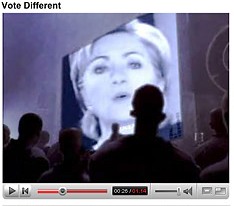
Figure of Speech: antistrephon (an-TIS-tre-phon), the boomerang figure. From the Greek, meaning “turning to the opposite side.”
A mysteriously produced video takeoff on Apple’s famous “1984” ad shows a zombified audience staring at a giant screen while a scary-looking Senator Clinton speaks. The video ends with an athletic woman shattering the screen with a sledgehammer. Why did the video’s makers choose to have Hilary talk about a “conversation”? Because they want to turn a favorable label against her. Watch the ad, and “conversation” sounds like a dictator’s doublespeak.
The video constitutes a masterful antistrephon, a figure of redefinition that turns your opponent’s term against him. The technology makes this seem like a new political tactic. But in the early 1800s, politicos used the same rhetorical device: they printed anonymous pamphlets that boomeranged their rivals’ terms.
YouTube’s political videos, in other words, are nothing more than computerized pamphleteering.
Snappy Answer: “When do I get to talk?”